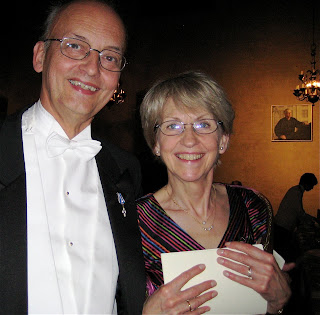The program opened with two pieces by the late renaissance composer Jacobus Gallus (originally from Slovenia, although he worked primarily in Vienna and Prague, also known as Jacob Handl), “Veni Sancte Spiritus” and “Subsannatores subsannavit Deus.” This was followed by the Martin Mass, in a very strong performance, shaped nicely by Martina. Finally, there were two works by the contemporary Slovenian composer Damijan Mocnik (sorry, I can’t find a way to write the proper diacritical marking over the c), “Hymnus Tertiae horae” and “Veni, Creatur Spiritus.” Both were interesting pieces, the second, based on the chant, calling for a larger group at the front of the church (which Gary led) and a smaller group from the back and sides led by Martina, particularly interesting. Mocnik was born in 1967 and I discovered he’d been a composer in residence on Orcas Island in Washington State last year (why didn’t I know about it?). An interview with him can be found here.
Martina was born in 1978, graduating from the Conservatory in Ljubljana in 2002, then going to the Hochschule in Munich for a diploma in choir conducting in 2005. Immediately after that she was offered the position of choirmaster at the opera in Ljlubljana, a full-time job she’s held since then. As part of winning the Ericson competition, she conducted a program with the Swedish Radio Choir last fall, and has been invited back for programs in the next two years.
Eric Ericson was also at the concert, so we had a chance to visit.

Also attending was Ingemar Månsson, who had the Hägerstens Motet Choir in Stockholm for years (Sven-David Sandström was a member of that choir for 20 years). He moved to Lund (in Skåne, in southern Sweden) and for some time has directed the Lunds Vocal Ensemble, which has won a number of prizes in European competitions. It was nice to see him again, too.
We were invited back to Gary and Maria’s house for a barbecue with the choir and Martina. Also along was an Australian conductor and teacher, Ingrid Leibbrandt, who’s been visiting and studying in Sweden since the mid-80’s. Ingrid wrote a book, On the Road to Paradise, which consists of interviews with Eric, Ingvar Lidholm, and others, and analyses of several seminal Swedish choral works (you can find a review of my book and Ingrid’s in the Summer/Fall edition of the American Choral Review here). I don’t have a copy yet, but will certainly get one. Ingrid is delightful and it was wonderful to meet her. She’s currently involved in a project with Eric of editing video footage of Eric rehearsing (she herself took more than 100 hours of such footage, following through a program from first rehearsal to performance). I absolutely hope she can get funding to put together this material in a form that can be easily accessible so that future generations can not only hear the results of Eric’s work, but can get a sense of how it is achieved.
Ingrid, Martina, and me:

The party itself was great fun, as are all parties at Gary and Maria’s house. Members of the choir brought whatever they wanted to barbecue and a variety of other salads, breads, desserts, wine, etc. They’re a fun group to be with and we’ve gotten to know a few of them fairly well, particularly after the project we did together at IFCM in Minneapolis and later in Uppsala in 2002—and of course, we just keep showing up at their concerts and parties!
The weather has begun to change—a little cooler, cloudier, and with a bit of rain (when Gary, Martina, Ingrid, Kathryn and I chose to take a walk down to the Baltic was the only time it really rained hard that afternoon!). My parents arrive on Wednesday for two weeks, so we hope there will be a bit more sun during that time.








_%26_Folke_Alin_(R).IMG_0606.jpg)

















